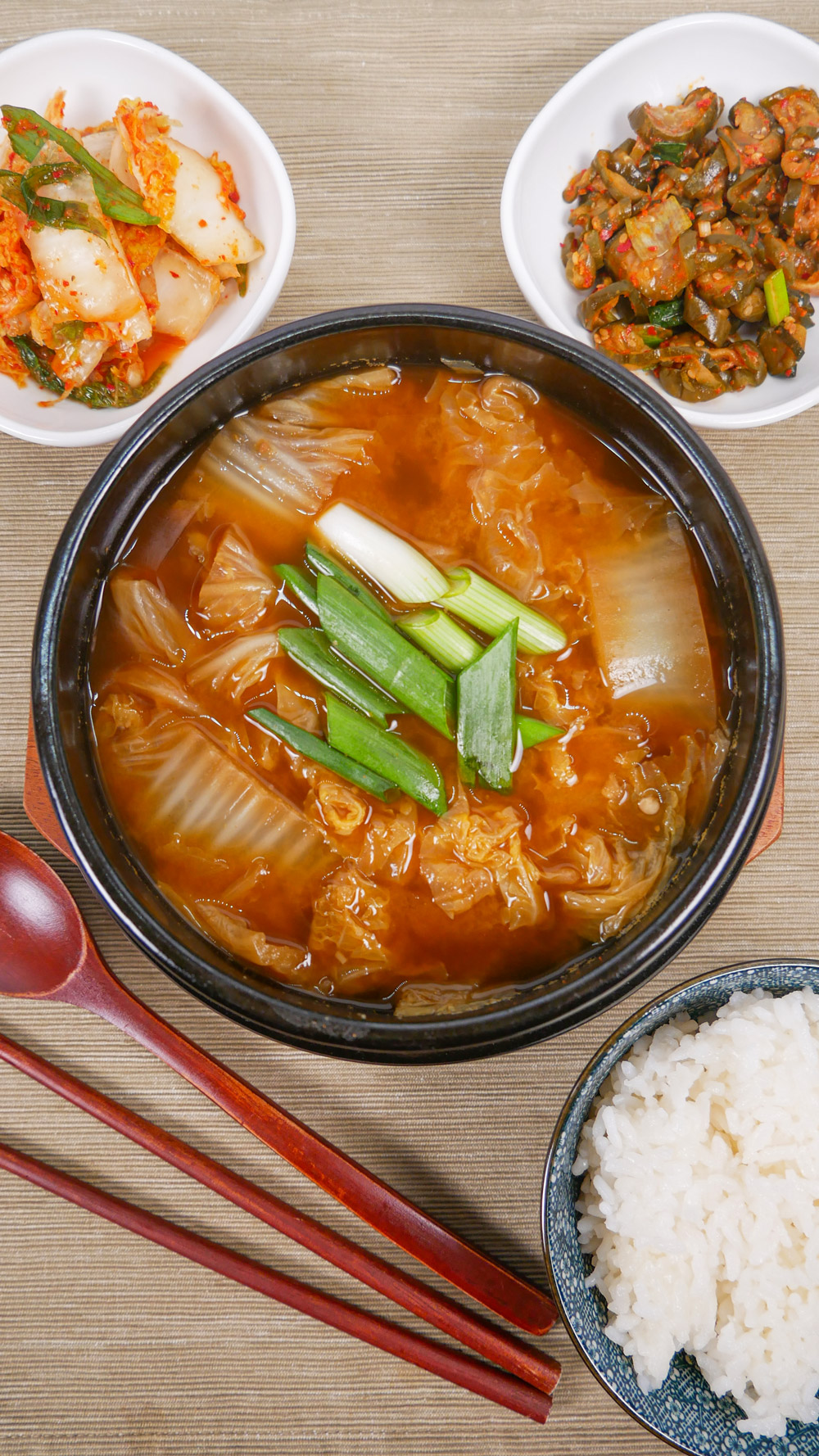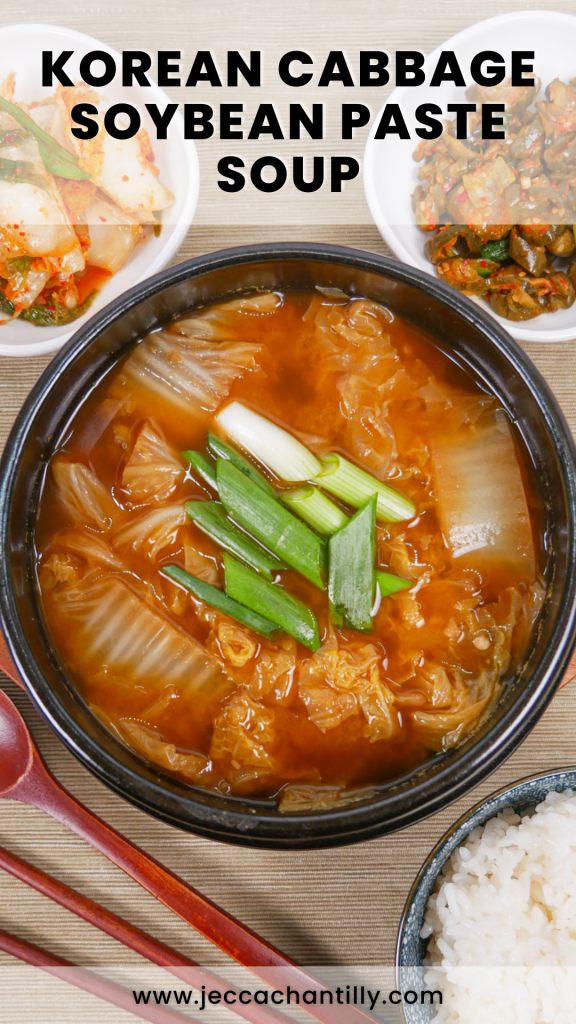Whenever I’m craving something quick, homey, and comforting, I always make this cabbage soybean paste soup or ‘baechu doenjang guk’. It’s a very nostalgic soup and reminds me of home every single time.
This soup is usually made with an anchovy broth that takes 20 minutes to prepare. However, I wanted a way to speed up the cooking time while maintaining the integrity of the flavors of the soup. I’ve figured out a way to cut the cooking time in half by using homemade anchovy powder!
The anchovy powder replicates the same flavors of the anchovy broth, which is usually made by simmering dried anchovies, kelp, and aromatics in water. This hack is such a time saver and my go-to whenever I want to make a quick and delicious Korean soup or stew.
Why you’ll love this recipe
Cabbage soybean paste soup isn’t often served in restaurants, but it’s a staple in Korean households. It only requires simple ingredients and takes less than half an hour to prepare. Plus, it’s light and healthy and perfect for any time of day.
This soup is also very versatile. Feel free to toss in any assortment of vegetables that you desire. Some great additions include mushrooms, zucchini, and potatoes.
For a heartier meal, you can try making a Korean Soybean Paste Stew called ‘doenjang jjigae‘ filled with tofu and vegetables. The broth is thicker, but it still has the delicious umami flavor of the doenjang (Korean soybean paste).
For best results, make sure to use the freshest napa cabbage you can find. When selecting the napa cabbage, they should have bright green leafy ends. While napa cabbage is ideal for this recipe, you can also use regular green cabbage if your local market doesn’t carry napa cabbage.
Ingredients & Substitutions
Napa cabbage: napa cabbage is the star of the show, but you can also substitute it with green cabbage or other vegetables, such as bok choy, spinach, and bean sprouts
Doenjang: doenjang or Korean soy bean paste is very salty and packed with umami flavors. It’s the main ingredient used to flavor the soup so there is no substitute for it. My favorite one is CJ Premium Dadam Doenjang which can be found at H Mart or on Amazon.
Gochujang: the gochujang adds a very subtle kick to the soup. You don’t want to add too much otherwise, it can overpower the doenjang.
Soup soy sauce: soup soy sauce complements the doenjang to build the salty and umami flavors of the soup, but you can also use salt or fish sauce as a substitute. If using fish sauce, you can use the same amount as soup soy sauce that the recipe calls for. If using salt, I recommend starting with ½ teaspoon and adjusting as needed.
Garlic & Scallion: the aroma and fragrance of the garlic and scallion enhance the flavors of the soup. You could omit this but I don’t think it would taste as good.
Green pepper: the green pepper adds another layer of spiciness, however, this can be omitted if you prefer a milder soup. You can also use jalapeno or serrano peppers.
Anchovy powder: the anchovy powder provides the deep and umami flavor of an anchovy broth. But if you haven’t had a chance to make my anchovy power in advance, here’s how you can make anchovy broth:
In a pot, combine 4 cups water, 8 dried anchovies (innards removed), 3-4 pieces of dried kelp (about 2×2 inches per piece), and ¼ onion. Bring over medium heat for 15 to 20 minutes the strain. This should yield about 2 ½ cups of broth.
How do I prepare Cabbage Soybean Paste Soup?
If you’re craving something comforting, this cabbage soybean paste soup will hit the spot. To make this dish, follow the steps below:
Step 1: Chop the vegetables
Chop the napa cabbage into 1-inch pieces. Next, mince the garlic. Chop the scallions and long green pepper. Set the vegetables aside while you prepare the rest of the ingredients.
Step 2: Make the anchovy broth
Bring a pot of water to a boil over medium heat. Mix in the doenjang, gochujang, soup soy sauce, and anchovy powder.
Step 3: Add the vegetables
Bring to a boil and add the napa cabbage and minced garlic. Cook for about 15 minutes or until the cabbage softens.
Step 4: Adjust the seasonings
Taste the soup and add more soup soy sauce if needed. Toss in the scallions and pepper and cook for another 3 to 5 minutes.
Step 5: Serve!
Once you’re satisfied with the taste, transfer the soup to a bowl and serve immediately with a bowl of rice. Enjoy!
Cooking Tips for Cabbage Soybean Paste Soup
Preparing this recipe requires no fuss because it only requires a few steps and ingredients. But to make the process even easier, here are a few tips you can keep in mind:
- If you’re making rice to go with the soup, you can save the water you use for rinsing the rice. It adds starch to the soup, making it thicker and more flavorful.
- Most of the flavor in the soup will come from the doenjang so I highly recommend using a good-quality doenjang. My favorite one is CJ Premium Dadam Doenjang which can be found at H Mart or on Amazon.
- The taste and intensity of doenjang differ between brands. Some brands are saltier than others so it’s important to taste as you go. If you find that the soup is too salty or the doenjang is overpowering, add more water. If the soup is lacking the doenjang flavor, add more doenjang a teaspoon at a time.
- A little bit of soup soy sauce goes a long way. Soup soy sauce is saltier than regular soy sauce so a little goes a long way. Similar to the doenjang, taste as you go and adjust as needed.
- A half head of uncooked napa cabbage may look like a lot for one soup. But its volume will drastically decrease once they’re cooked.
- Feel free to increase or decrease the amount of gochujang and green pepper added depending on your preferred spice level.
Frequently Asked Questions
What is doenjang?
Doenjang is a Korean fermented soybean paste that’s used for flavoring soups, stews, ssamjang, and side dishes in Korean cuisine. It’s made from fermenting cooked soybeans, salt, and brine for months, so it has a strong umami and salty taste. You can find doenjang in grocery stores, Asian markets, and online. Remember to keep it in the fridge to extend its shelf life.
What is soup soy sauce?
Soup soy sauce is the leftover liquid you get from doenjang. It has a similar flavor profile to the paste, so it complements this recipe well. It’s also used to flavor stews and vegetables because of its potent salty and umami taste. It may have a lighter color than regular soy sauce, but it has a deeper and saltier flavor.
Can you boil the cabbage before adding it to the soup?
Some recipes recommend parboiling the cabbage for about 1 minute in water before adding it to the soup. This is done to remove any dirt on the leaves so they’re safe to eat. You can do this step if you prefer, but you don’t necessarily have to as long as you wash the leaves well under running water.
Can you make cabbage soybean paste soup in advance?
Yes, you can! This soup can be made 1 to 2 days in advance. The flavors from the soup will be absorbed into the cabbage. So the longer the soup sits, the more flavorful the cabbage will taste.
Can you store the soup in the fridge?
Yes, you can store any leftover soup in the fridge. Just let it cool down to room temperature before placing it in an airtight container. Refrigerate and it will stay fresh for up to 5 days. You can reheat it on the stovetop or microwave for 1 to 2 minutes or until it’s thoroughly hot.
Can you freeze cabbage soybean paste soup?
I don’t recommend freezing the soup since it can affect the texture of the cabbage and cause it to get quite mushy. You can freeze the broth alone, and it will stay fresh for 2 to 3 months. Only add the cabbage once you heat the broth and are ready to serve.
Looking for more easy and delicious soup recipes?
For more heartwarming soups, check out these recipes below:
1. Korean Pork Bone Soup (Gamjatang) – if I could only make one dish for the rest of my life, I would choose this recipe. It’s a spicy soup served with soft and tender meat and an assortment of vegetables. It’s the ultimate Korean comfort food!
2. Korean Mussel Soup (Hong Hap Tang) – this soup is light and refreshing with a little kick to round out the oceany flavors. If you love fresh mussels, don’t miss out on this dish!
3. Korean Rice Cake Soup (Dduk Guk)– this soup is a Lunar New Year staple because it’s believed to bring good luck and prosperity for the new year. But you can honestly have it any time of year. It’s thick, hearty, and served with rice cakes!
4. Korean Fish Cake Soup – this is a classic Korean street food soup that you should try at least once in your life. It has skewered fish cakes that are served with a light and refreshing broth. It’s a comforting dish to eat with tteokbokki or japchae dumplings!
5. Spicy Seafood Noodle Soup – if you’re looking for a spicy soup recipe, this is exactly what you need. It has a thicker broth which adheres better to the noodles, and I love it because it makes each bite more flavorful!

Baechu Doenjang Guk (Cabbage Soy Bean Paste Soup)
Ingredients
- 1/2 head napa cabbage about 1/2 lb
- 2.5 cups water
- 2 tbsp doenjang Korean soy bean paste
- 1 tsp gochujang Korean red pepper paste
- 1/2 tbsp soup soy sauce adjust to taste
- 1/2 tbsp garlic minced
- 1 scallion chopped
- 1 long green pepper chopped
- 1/2 tbsp anchovy powder
Instructions
- Chop the napa cabbage into 1 inch pieces. Set aside.
- Mince the garlic. Chop the scallions and long green pepper.
- Bring a pot of water to boil. Mix in the doenjang, gochujang, soup soy sauce and anchovy powder.
- Bring to boil and add the napa cabbage and minced garlic. Cook for about 15 minutes until cabbage has softened.
- Taste the soup and add more soup soy sauce if needed. Toss in the scallions and pepper and cook for another 3-5 minutes.
- Serve immediately with a bowl of rice.
Pin & save this recipe for later!
